2,642 bears were harvested in Pennsylvania in 2024; three bears exceeded 700 pounds
By Steven Brodsky
It would be a bear for me to not share this news release that was issued by the Pennsylvania Game Commission (PGC) on April 22, 2025:
BIG BEARS AMONG THOSE HARVESTED IN 2024
They don’t grow them this big everywhere, but Pennsylvania has its share of giant bears.
Released today by the Game Commission, the 2024 bear harvest totals prove that yet again.
Consider the Venango County bear Heath Bromley, of Titusville, got with a crossbow in October. It weighed in at 597 pounds – a tremendous bear any hunter would be happy to take.
And yet, it was just the 10th heaviest harvested by a Pennsylvania hunter in the 2024 seasons. The harvest’s nine bigger bears all topped 600 pounds, with three of them exceeding 700 pounds.
Scott Price, of Madison Township, Lackawanna County, got the largest of them all in Monroe County during the statewide regular bear season in November. It weighed 774 pounds.
Impressive as those animals are, the fact hunters run into them isn’t unusual. Pennsylvania hunters harvest big bears every year.
“Pennsylvania is home to lots and lots of great bear-friendly habitat, areas with abundant and varied food sources and thick cover,” said Brandon Snavely, the Game Commission’s black bear biologist. “That allows us not only to support lots of bears, but plenty of very, very big ones, too.”
In all, hunters harvested 2,642 bears during the 2024 seasons, placing the 2024 harvest in the top 25 on record.
As in past years, the overall bear harvest was spread across the state. Fifty-six of 67 counties gave up at least one bear, as did 21 of 22 WMUs. Hunters got bears in all seasons, too. The traditional statewide firearms bear season contributed the most to the harvest, with 823 animals. The archery season added 756, the extended season 425, the muzzleloader and special firearms season 634 and there were four harvests in the early archery season.
Between Bromley’s bear and Price’s bear, the others in the top 10 by weight are: a 714-pounder taken in rifle season in Perry Township, Clarion County, by Matthew Conto of Slippery Rock; a 700-pounder taken in archery season in Harrison Township, Potter County, by Henry Mast of Harrison Valley; a 689-pounder taken in rifle season in Chapman Township, Clinton County, by Michael Gerg of Kersey; a 681-pounder taken in archery season in Sharon Township, Potter County, by Tyler Birdsall of Milton; a 681-pounder taken in rifle season in White Haven Borough, Luzerne County, by Stanley Boc of Huntingdon Valley; a 678-pounder taken in the muzzleloader season in Lightfield Township, Bradford County, by Scott Tiffany of Athens; a 673-pounder taken in archery season in Mount Pleasant Township, Westmoreland County, by Jeffrey Prinkey of Connellsville; and a 615-pounder taken in archery season in Jefferson Township, Dauphin County, by Dennis Morgan of Halifax.
Among counties, Tioga produced the most, giving up 163 bears last season. It was followed in the top 10 by Clinton with 157, Lycoming with 148, Bradford with 133, Potter with 109, Luzerne with 95, Monroe with 93, Pike with 85, McKean with 78 and Sullivan with 75.
Final county harvests by region (with 2023 figures in parentheses) are:
Northwest – 385 (357): Forest, 48 (68); Warren, 67 (65); Venango, 74 (64); Jefferson, 60 (50); Clarion, 57 (44); Butler, 38 (29); Crawford, 20 (24); Erie, 10 (8); and Mercer, 11 (5).
Southwest – 174 (141): Armstrong, 40 (41); Somerset, 34 (32); Indiana, 32 (24); Fayette, 30 (23); Westmoreland, 18 (13); Cambria, 18 (5); Greene, 2 (1); Beaver, 0 (1); and Allegheny, 0 (1).
Northcentral – 918 (1,034): Tioga, 163 (176); Lycoming, 148 (170); Potter, 109 (155); Clinton, 157 (108); Elk, 44 (90); McKean, 78 (90); Cameron, 56 (85); Clearfield, 67 (72); Centre, 64 (71); and Union, 32 (17).
Southcentral – 193 (162): Bedford, 40 (34); Mifflin, 14 (28); Huntingdon, 49 (25); Juniata, 13 (19); Perry, 12 (14); Blair, 18 (11); Adams, 7 (10); Franklin, 9 (9); Cumberland 11 (6); Fulton, 16 (4); and Snyder, 4 (2).
Northeast – 805 (1067): Pike, 85 (142); Bradford, 133 (138); Luzerne, 95 (135); Monroe, 93 (127); Wayne, 63 (124); Carbon, 62 (101); Sullivan, 75 (75); Susquehanna, 47 (67); Wyoming, 62 (62); Lackawanna, 31 (57); Columbia, 45 (27); Northumberland, 13 (10); and Montour, 1 (2).
Southeast – 167 (159): Schuylkill, 64 (65); Dauphin, 45 (42); Northampton, 28 (21); Berks, 18 (16); Lebanon, 9 (10); and Lehigh, 3 (5).
The final bear harvests by Wildlife Management Unit (with final 2023 figures in parentheses) were:
WMU 1A, 26 (19); WMU 1B, 67 (53); WMU 2A, 6 (3); WMU 2B, 2 (3); WMU 2C, 102 (87); WMU 2D, 173 (146); WMU 2E, 53 (41); WMU 2F, 213 (247); WMU 2G, 476 (565); WMU 3A, 203 (203); WMU 3B, 303 (343); WMU 3C, 145 (221); WMU 3D, 287 (451); WMU 4A, 71 (42); WMU 4B, 50 (47); WMU 4C, 197 (220); WMU 4D, 143 (124); WMU 4E, 96 (72); WMU 5A, 10 (18); WMU 5B, 2 (0); WMU 5C, 17 (15); and WMU 5D, 0 (0).
Last year, 201,280 hunters bought bear licenses for the 2024 seasons. It was the sixth-straight year bear license sales topped 200,000.
Game Commission Executive Director Steve Smith said that sustained high interest isn’t surprising. While a hunter’s odds of filling a bear tag are somewhat slim, Smith said, the exciting prospects of what might happen on any given bear hunt are always present and help fuel tradition.
“Bear hunting combines so many of the elements that keep hunters coming back,” Smith said. “For some, there’s the camaraderie of going to camp or hunting with family and friends. Others might venture out alone. There’s an array of seasons. But no matter how you hunt, there’s always the anticipation of seeing a bear and making the most of your opportunity. And that opportunity, literally, might be extremely big.”
Posted 4-24-25
The Pennsylvania Game Commission (PGC) plans to spray 38,146 acres of state game lands this spring to protect forest habitats from severe damage by spongy moths
By Steven Brodsky
The Pennsylvania Game Commission (PGC) issued this news release yesterday, April 21, 2025:
GAME COMMISSION ANNOUNCES SPRAYING PLANS
In an effort to protect wildlife habitat, the Pennsylvania Game Commission plans to spray over 38,000 acres of state game lands this spring.
Spongy moths previously were known by the common name gypsy moth, but the Entomological Society of America has changed the name. Spraying is planned for 16 different state game lands – 38,146 acres in all – and will begin as soon as leaf-out occurs and spongy moth egg masses hatch, likely in late April and May. No spraying will be scheduled the mornings of youth turkey season (April 26) or the opening day of spring gobbler (May 3).
“Those participating in spring gobbler seasons or otherwise enjoying state game lands may encounter aircraft spraying forested areas for spongy moths,” said Paul Weiss, the Game Commission’s Chief Forester. “We recognize some hunters might be temporarily affected by these activities, but disturbances are brief and only temporary, and by protecting these valuable habitats against a destructive, invasive pest, the forests will provide hunters the opportunity to chase gobblers there for generations to come.”
This year’s spraying will occur in the following regions: Southcentral, Northcentral, Southeast, and Northeast. The Northwest and Southwest Regions have no spraying scheduled this year. Most of the blocks of forest to be sprayed can be treated within one day, often within only a few hours.
The forests to be treated in the coming weeks have building populations of spongy moths that, if left untreated, could cause severe defoliation this summer.
“Oaks are the main target of spongy moths, and they also provide the best and most reliable wildlife foods,” Weiss said. “Unfortunately, in some areas, we have seen birch and maple replace the oak stands lost to past spongy-moth defoliation. This loss of acorn availability across such a potentially large area can have extremely detrimental impacts on wildlife populations ranging from chipmunks and squirrels all the way up to deer and bears. Even if the oak trees manage to survive damage caused by this defoliation, the reduction of acorn production can linger for years after. The Game Commission has made the decision to aggressively treat this problem to protect the wildlife resources in the immediate future as well as into the longer term.”
Oak forests also are important habitats for pollinator and other insect species. This promotes a healthy food chain ultimately benefiting all wildlife species.
Timothy Haydt, Director of the Game Commission’s Bureau of Wildlife Habitat Management, noted that, based on the value of state game lands’ oaks for wildlife, the agency simply can’t afford to forgo spraying this year.
“We know that oak forest habitats are tremendously valuable to all wildlife,” Haydt said. “Acorns are an essential staple of the diet of small and large bird and mammal species found in Pennsylvania. The energy gained by consuming acorns in the fall and winter months allows wildlife to survive the often-harsh conditions encountered prior to spring green up. Acorns are also a preferred food source for our prized game species including wild turkeys, deer, black bears, ruffed grouse and several species of ducks.
The insecticide to be used is Mimic 2LV. Its active ingredient is tebufenozide. This agent generally is considered safe to humans. Most negative side effects happen with repeated, long-term exposure to high concentrations of the product. As with any chemical, it may cause eye or skin irritation if exposed, and it is recommended to wash any affected area if irritation occurs.
More information on spongy moths and the Game Commission’s spraying program, including a map updating the status of spraying is available on an interactive web page at www.pa.gov/pgc.
Posted 4-22-25
The Brandywine Conservancy has launched the Brandywine Native Garden Hub, an interactive website for those interested in the native plants of Pennsylvania and northern Delaware; the new website includes information on more than 250 native plant species
By Steven Brodsky
… The Brandywine Native Garden Hub website will be a great resource for many of you.
The Brandywine Conservancy issued this press release yesterday:
Chadds Ford, PA, April 14, 2025 — In celebration of National Gardening Month, the Brandywine Conservancy is thrilled to announce the launch of the Brandywine Native Garden Hub, a new online resource designed to inspire gardeners of all levels and skillsets. The Brandywine Native Garden Hub is a free, user-friendly website that serves as both an educational guide and an interactive database for anyone interested in incorporating native plants into their landscapes. Naturally occurring in a specific region without human intervention, native plants have adapted to the climate and soil over time, making them easier to grow and maintain, plus they directly benefit pollinators, wildlife, and the local ecology. With the Brandywine Native Garden Hub, users can search for and learn more about native plants specific to Pennsylvania and northern Delaware, save their favorites to personalized “Garden Boards,” and browse through a suite of educational resources to help enhance their gardening success.
“We are so excited to share the Brandywine Native Garden Hub with our broader community,” said Stephanie Armpriester, Director of Conservation and Stewardship at the Brandywine Conservancy. “Our main goal with this new website is to break down barriers for those interested in getting started with native plants and to provide them with all the tools they need to begin their garden journeys. With this accessible online resource, we hope to inspire beginners to join us in our important mission-related work in their own backyards and landscapes. It’s also a perfect companion tool to the slate of educational programs the Brandywine Conservancy offers around native plants throughout the year, as well as our annual Native Plant Sales, both here on our campus in Chadds Ford, PA and in Western Pennsylvania at our Penguin Court Preserve.”
Now available at www.NativeGardenHub.org, the Brandywine Native Garden Hub contains information on more than 250 native plant species found in our region. Each plant profile contains everything you need to know about the plant—from growing conditions to key attributes and wildlife benefits—along with photos that show different growth stages. Users can also personalize their searches by filtering for plants according to their garden’s specific growing conditions, including sunlight exposure, soil type, and soil moisture. Plants can even be sorted by the user’s preferred attributes and benefits, including plant type, height/width, peak bloom time, bloom color, deer resistance, fragrance, and more.
To help visualize and plan their dream gardens, users can create a free account to build personalized “Garden Boards” that are customized to their unique growing spaces. Boards can be curated for the spaces users currently have, the type of gardens they are looking to start—such as a container garden for smaller spaces or one designed to attract specific pollinators—or even boards for future garden inspiration. Once users set up their boards, they can “pin” their favorite plants while browsing to save them for building out their garden plans. Users can also add, edit, and create as many Garden Boards as they’d like, which can be referenced at any time on both desktop and mobile devices.
To equip users with even more tools for success during their gardening journeys, the Brandywine Native Garden Hub also features a wealth of educational resources. Users can dive into our beginners guide for getting started with native plants or browse through other articles, including topics on how to prep a container garden, tackling invasive species, and seasonal gardening tips. Additional articles will be published throughout the year for continued learning.
For more than five decades, the Brandywine Conservancy has been a trusted leader in growing and promoting the use, preservation, and appreciation of native plants. The Brandywine Native Garden Hub is the latest extension of this work, providing a digital platform to help gardeners bring the benefits of native plants to their own landscapes. To start your journey with native plants, visit www.NativeGardenHub.org.
The launch of this new online resource also comes at the perfect time, right before the return of the Brandywine Conservancy’s annual Wildflower, Native Plant & Seed Sale on May 10-11, 2025 (with early member access available on May 9). Held outside in the Brandywine Museum of Art’s courtyard in Chadds Ford, PA, the sale includes a wide variety of native wildflowers, grasses, ferns, vines, shrubs and trees. The Brandywine Native Garden Hub is a great resource to reference in advance of the sale and can be used to create a “shopping list” with a custom Garden Board to bring to the event. More information on the Native Plant Sale can be found at www.brandywine.org/native-plant-sale.
Created by the Brandywine Conservancy, the Brandywine Native Garden Hub was designed and developed by Infantree—a creative agency based in Lancaster, PA—and made possible through a generous grant from the Allegheny Foundation.
About the Brandywine Conservancy:
The Brandywine Conservancy protects water, conserves land, and engages communities. The Conservancy uses a multi-faceted approach to conservation. Staff work with private landowners who wish to see their lands protected forever and provide innovative community planning services to municipalities and other governmental agencies. The Conservancy currently holds more than 510 conservation and agricultural easements and has facilitated the permanent preservation of over 70,200 acres of land. The Conservancy is a program of the Brandywine Conservancy & Museum of Art.
About the Brandywine Conservancy & Museum of Art:
The Brandywine Conservancy & Museum of Art preserves and promotes the natural and cultural connections between the area’s beautiful landscape, historic sites, and important artists. The Conservancy protects the lands and waters throughout the Brandywine Valley and other priority conservation areas, developing sustainable approaches to emerging needs and assuring preservation of majestic open spaces and protection of natural resources for generations to come. The Museum of Art presents and collects historic and contemporary works of American art, engaging and exciting visitors of all ages through an array of exhibitions and programs. The Brandywine unites the inspiring experiences of art and nature, enhancing the quality of life in its community and among its diverse audiences.
Posted 4-15-25
Winter will end this month in the Northern Hemisphere
By Steven Brodsky
… and most of this column’s readers are looking forward to the arrival of spring, a season with weather that’s generally more conducive to enjoying activities in the great outdoors.
When and where those activities (camping, fishing, etc.) will take place at night (especially in the absence of ambient light), children and adults can contemplate with awe, Psalm 8:3-5: “When I consider thy heavens, the work of thy fingers, the moon and the stars, which thou hast ordained; What is man, that thou art mindful of him? and the son of man, that thou visitest him? For thou hast made him a little lower than the angels, and hast crowned him with glory and honour.”
Posted 3-3-25
Some of the best bird photos
By Steven Brodsky
… that birders contributed to the Cornell Lab of Ornithology’s Macaulay Library archive in 2024 are accessible for you to view online.
Enjoy: https://www.allaboutbirds.org/news/macaulay-librarys-best-bird-photos-2024/.
Posted 1-13-25
It wasn’t you, nor was it me
By Steven Brodsky
… who made this tree:
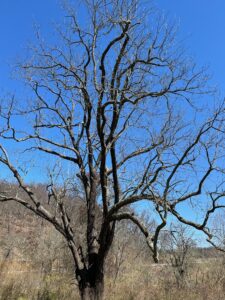
Photo by Steven Brodsky
“Trees,” by Joyce Kilmer: https://www.poetryfoundation.org/poetrymagazine/poems/12744/trees
The tree was photographed yesterday.
The Joyce Kilmer poem was published in August 1915.
This post originally appeared at: Conversations About Faith – delcoculturevultures.com.
Posted 3-25-24, Reposted and Revised 11-21-24
In a proper season
By Steven Brodsky
… appeared this frog (and the shadow it cast upon a lotus leaf):
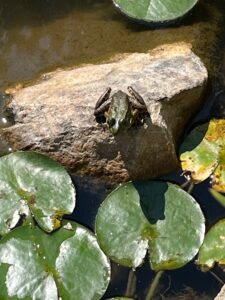
Photo by Steven Brodsky
Ecclesiastes 3 KJV (biblehub.com)
This post appeared in the Conversations About Faith section of this column.
Posted 4-25-24, Reposted and Revised 8-14-24
Exquisite is the monarch butterfly chrysalis stage
By Steven Brodsky
… as pictured here:
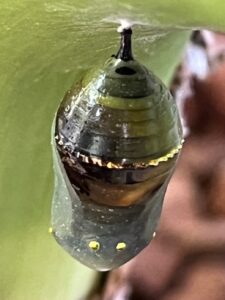
Photo by Steven Brodsky
I can’t say that I find the adult stage of the monarch butterfly to be more exquisite than the monarch chrysalis stage.
Which stage is more exquisite?
Not an easy question (for me) to answer.
It’s easier to simply enjoy seeing these two life stages of the monarch butterfly in the great outdoors!
Posted 8-7-24
Coming into the peace of some wild things
By Steven Brodsky
… with this photo and “The Peace of Wild Things”:
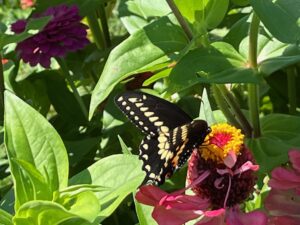
Photo by Steven Brodsky
Posted 7-9-24
‘Nature rarer uses yellow’
By Steven Brodsky
… wrote Emily Dickinson: https://www.online-literature.com/dickinson/poems-series-2/106/.
Thought of the poem today when this early spring spattering of translucent yellow came into view trailside in a National Park:
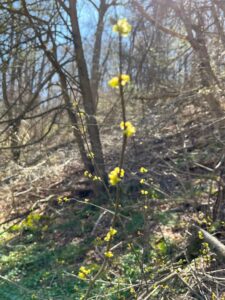
Photo by Steven Brodsky
Some of this column’s readers will recall the Emily Dickinson poem the next time that they take notice of nature’s yellow in the great outdoors.
Posted 3-24-24
A tarantula species was named after Johnny Cash 8 years ago, on February 5, 2016
By Steven Brodsky
… The species is found near Folsom State Prison, the venue where Johnny Cash’s first live album, Johnny Cash at Folsom Prison, was recorded on January 13, 1968. The album was released on May 6, 1968.
Folsom State Prison is located in Folsom, California.
The tarantula species is named Aphonopelma johnnycashi: http://www.sci-news.com/biology/aphonopelma-johnnycashi-new-tarantula-species-johnny-cash-03615.html.
Posted 2-5-24
Most people can relate
By Steven Brodsky
… to the kind of death that was experienced by the character in Seamus Heaney’s poem “Death of a Naturalist.”
Posted 7-12-22
A Conversation With Katie Fallon, Author of ‘Vulture: The Private Life of an Unloved Bird’
By Steven Brodsky
Katie Fallon is a co-founder of the Avian Conservation Center of Appalachia. She’s worked with many species of raptors and other kinds of birds. Katie’s books include Cerulean Blues (2011) and the recently released Vulture: The Private Life of an Unloved Bird. Her essays have appeared in a number of literary journals. She has a lifelong love of nature. I’ve heard that the first word she ever spoke was “bird.”
Your new book gives vultures, particularly turkey vultures, the positive attention these non-predator raptors deserve. What brought about your interest in these maligned birds?
I’ve been fascinated by vultures for at least fifteen years. There was a roost near where I lived in West Virginia; every day I’d drive by this big, old dead tree with ten or so turkey vultures hunched in it. They became a familiar sight, and I looked forward to seeing them. Vultures are big and kind of dramatic, and in flight, there’s nothing more beautiful. In addition, they’re the ultimate recyclers—they turn death into life.
Many people in the U.S. have an aversion to vultures. Speak about this.
I think vultures remind people of their own mortality. It can be a little creepy to think about a large, dark bird waiting to consume your body when you die. In general, I don’t think people in the US are comfortable with thinking of our bodies as food. Vultures remind us that life will continue after we die, and that some life will continue because we die. They remind us of our animal bodies. Which can be unnerving!
In the absence of vultures, we’d have major health issues to contend with. Tell us why.
Vultures clean up our ecosystems by removing animal carcasses that could potentially contaminate soil and water. They can eat animals that have died of anthrax and botulism. In the absence of vultures, mammalian scavengers could increase in number, and many mammalian scavengers such as raccoons, skunks, feral dogs and cats can spread rabies; vultures do not. Several vulture species in India have suffered catastrophic population crashes in the last twenty years, and public health has suffered. India leads the world in human rabies cases, and the number of cases has increased as the number of feral dogs increased in the absence of vultures.
People get close to vultures by attending your presentations that feature non-releasable birds. How are these birds acquired? How are they trained?
The nonprofit I co-founded, the Avian Conservation Center of Appalachia, keeps eight non-releasable raptors for educational purposes (you need permits from the US Fish & Wildlife Service to do this, of course – the birds aren’t pets or personal property). All of our birds were injured wild birds that cannot return to the wild. We have three vultures. Lew the turkey vulture was hit by a car and suffered an injury to his shoulder that prevents flight. His “girlfriend,” Boris, was shot in the wing, and by the time she reached us the bone had already healed incorrectly. Our black vulture is Maverick, and he was hit by a car, which resulted in a shoulder injury that prevents adequate flight.
Our birds are all trained using positive reinforcement. We avoid negative reinforcement and punishment, and we try to empower the birds to have some control over their environments. We condition behaviors by offering food rewards when the birds perform the behaviors. Vultures (especially our black vulture!) learn quickly, and they are a lot of fun to work with.
What myths and misunderstandings about vultures do these presentations help to dispel?
People are surprised at how clean and charismatic the vultures are – and how beautiful they are up close, despite their featherless heads.
What vulture behaviors do people find to be most interesting?
People often ask if vultures throw up on us; our education vultures usually don’t (unless they get scared). Vultures also expel liquid waste on their legs and feet, probably to clean them as well as to keep cool. This often fascinates people as well.
Which species of vulture are found in Pennsylvania and neighboring states?
We have turkey vultures and black vultures. During the last Ice Age we may have had California condors, too, and possibly some other now-extinct vultures.
What has been learned about migration of these species?
Hawk Mountain has taken the lead on turkey vulture migration research. Dr. Keith Bildstein and his team have placed transmitters and wing tags on turkey vultures all over the Americas. They’ve learned that our eastern turkey vultures are partial migrants—some spend the winters in Florida, some on the New Jersey shore, some in Virginia, and in many places in between. Many western turkey vultures are complete migrants, leaving their breeding ranges in Canada and heading all the way to South America. And still others in the American southwest migrate into Central America and return. It’s fascinating how the different subspecies have different migratory strategies. Dr. Bildstein and his colleagues have ongoing research projects about turkey vulture migration, and are discovering more all the time.
Vultures have spectacular flying ability. What makes this possible?
Turkey vultures are very light – they have almost the same wingspan as a bald eagle but weigh less than half what an eagle weighs. Their wings are long and broad, and are made for soaring.
How high can they fly?
The Ruppell’s vulture holds the record for the highest-flying bird. Unfortunately for that individual, it was hit and killed by a jet flying over Africa at 37,000 feet.
Vulture: The Private Life of an Unloved Bird informs readers about lead toxicity in vultures. What is the extent of the problem? How do vultures ingest lead?
Vultures (and eagles, hawks, crows, ravens, and owls) can ingest small pieces of spent lead ammunition in animal carcasses or “gut piles” left by hunters. When someone shoots a white-tailed deer, for example, the deer is usually field-dressed, and many of the organs are left. This can be a delight for vultures and other scavengers! In ecosystems, scavengers often follow the big predators to clean up the leftovers; here, the same thing is happening—a human is the big predator, a gut pile is the leftover, and a vulture or eagle is the scavenger. However, if small lead fragments are still in the gut piles, avian scavengers can inadvertently ingest the lead and become sick. Lead toxicity from spent ammunition is the biggest obstacle in the way of California condor recovery.
The Avian Conservation Center of Appalachia provides rehabilitation for injured birds. What kind of care do vultures receive?
We’ve treated vultures with a wide variety of injuries and ailments—broken bones, head trauma, lead toxicity, soft tissue injuries. Every bird we admit receives an immediate comprehensive examination by an avian veterinarian, and is then treated as necessary with antibiotics, antifungals, anti-inflammatories, fluid therapy, or chelation therapy. They also receive orthopedic surgery if necessary. We do our best to get the birds back out in the wild if possible.
It must be very joyful to enable an injured bird to regain flight ability. Please tell us about a memorable release.
Two and a half years ago we released a female turkey vulture that had been shot with a shotgun—she had three pellets embedded in soft tissue. We had to leave the pellets in her body because removing them would cause damage. Once she was nursed back to health, we released her wearing a transmitter to track her movements. We learned that she travels to northern Georgia in the winters and comes back to West Virginia in the breeding season. We are thrilled that this vulture was able to return to the wild—and thrive!
Vulture watching is growing in popularity. Turkey vultures are very widespread. Where are some of the best places and times to observe them?
In many parts of the southeastern United States, you can see turkey vultures any day of the year in a variety of habitats. In the winter, vultures can be observed roosting together in and near many cities: in Virginia, check out Leesburg, Staunton, Radford, Pulaski, and Charlottesville; in West Virginia, many vultures can be observed migrating in the fall over Hanging Rock Tower in Monroe County and over Harper’s Ferry in the eastern panhandle. During the summer and fall, the overlook at Cooper’s Rock State Forest near Morgantown, WV, is a sure place to see turkey vultures. Hawk Mountain in Pennsylvania, of course, is an excellent place to watch turkey vultures and birds of prey during migration, especially in September and October.
What stimulated your interest in nature?
I’ve always been an outdoors person. I grew up in northeastern Pennsylvania, and I had horses as a kid. I spent a great deal of time with my horses, trail riding and competing, and when I got a bit older I often went hiking and camping with friends and family. One of my favorite childhood hiking spots was Ricketts Glen State Park—it’s filled with hemlock trees and many gorgeous waterfalls. It’s definitely worth checking out if you visit northeastern PA.
Was “bird” your first word?
Yes! My parents had bird feeders in their yard when I was a baby (well, they still do) and my mother says she used to hold me in front of the window to show me the birds at the feeder. One day, she said, “Look at the birds! Look at the birds outside.” And I nodded and said, “Bird.” I haven’t stopped talking about them since.
Katie Fallon’s website address is: www.katiefallon.com.
Posted 4-6-17, Reposted 10-29-19